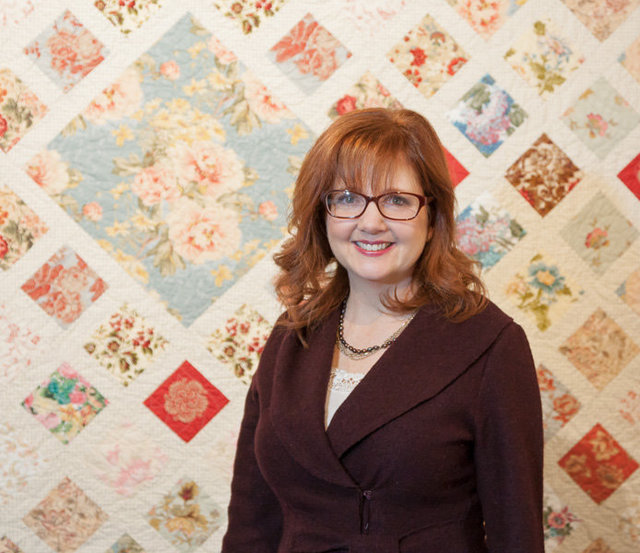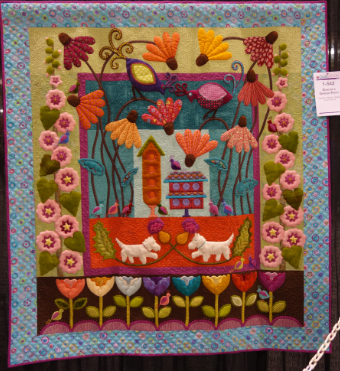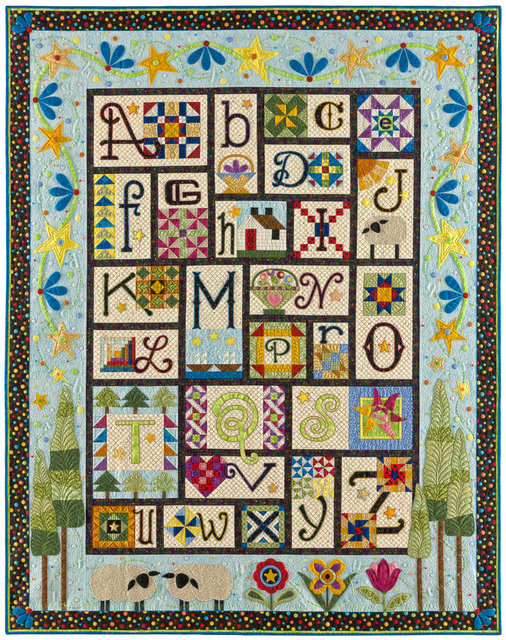Cheryl Arkison, author of the quilt book, "A Month of Sundays", continues her talk with Alex. This time they discuss "low volume fabrics". Click here to see the first video interview with Alex and Cheryl.
Cheryl Arkison, author of the quilt book, "A Month of Sundays", continues her talk with Alex. This time they discuss "low volume fabrics". Click here to see the first video interview with Alex and Cheryl.

Photo by Gregory Case Photography
The discovery that beloved English writer Jane Austen (1775 - 1817) had made a quilt, and a visit to the author's home in Chawton, England, was just the impetus that Karen Gloeggler needed to create a series of quilts (and a quilt book) inspired by Austen's romantic novels. In this episode, Karen shares how to find, and then incorporate vintage fabrics, handkerchiefs, and doilies into your quilts to give them a period flair, and shows a clever technique for making a scrappy pieced border, perfect for a Jane-inspired (or any other) quilt.
Then, in a field piece, we meet author and quilt historian Janet Finley, who has amassed the world's largest collection of 19th- and early-20th-century photos of people with quilts, and the book she created to showcase them.
 Metamorphosis ~ Clothing & Identity, is now showing at the San Jose Museum of Quilts & Textiles.
Metamorphosis ~ Clothing & Identity, is now showing at the San Jose Museum of Quilts & Textiles.
Metamorphosis: Clothing & Identity is a retrospective of the San Francisco Bay Area Art-to-Wear movement and traces the evolution of the rich history and legacy of this genre from its inception in the 1960s to the current group of second generation designers that are creating their own one-of-a-kind, handmade, artful garments. The exhibition will also present a “metamorphosis” of clothes that transcends functional attire and becomes sculptural manifestations of symbolic ideas that challenge our notion of clothing and identity.
(Chador for Two Worlds, 1984, Ina Kozel)
The discovery that beloved English writer Jane Austen had made a quilt, and a visit to the author's home in Chawton, England, was just the impetus that Karen Gloeggler needed to create a series of quilts and book inspired by Austen's romantic novels. Karen shares how to find and incorporate vintage fabrics, handkerchiefs, and doilies into your quilts to give them a period flair, and shows a clever technique for making a scrappy pieced border, perfect for a Jane-inspired quilt.
You'll also meet author and quilt historian Janet Finley, who has amassed the world's largest collection of 19th- and early-20th-century photos of people with quilts, and the book she created to showcase them.
The Episode 1405 debuts March 3. Don't miss it!
You'll fall in love with this adorable quilt, Duncan's Garden Party, by Karolyn "Nubin" Jensen which was exhibited at the AQS QuiltWeek Phoenix show in February 2014. If the puppies don't grab you, the little birdies will.

In honor of Grand Central Terminal's Centennial in 2013, The City Quilter designed four fabrics to commemorate this anniversary, and recruited American Patchwork & Quilting to sponsor a national quilt-making "challenge," a competition to make commemorative quilts that use these Grand Central fabrics and that exemplified what Grand Central meant to them.
The quilts were judged by American Patchwork & Quilting and The City Quilter.
Then the New York Transit Museum enthusiastically embraced an exhibition for its 1,000 square foot Gallery in Grand Central Terminal. There are 3 winners, 9 honorable mentions, and 18 finalists, all in this exhibit, quilt artists representing 15 states.
"Grand Central Centennial Quilts" will be in Grand Central from March 15 through July 6, with these hours: Monday–Friday, 8 am to 8 pm; Saturday & Sunday, 10 am to 6 pm.
According to Travel + Leisure magazine in a October 2011 survey, Grand Central Terminal is "the world's number six most-visited tourist attraction", bringing in approximately 21,600,000 visitors annually. Based on average attendance figures at the Transit Museum's GCT Gallery, we project 70,000 to 120,000 visitors.
The 30 quilts exemplify the artistic diversity of quilt art. As examples, here are the three prize winners You can view them all online via the APQ link provided.
Grand prize winner: Amy Krasnansky, Baltimore, MD
Quilt name: “Time Flies, But We Take the Train”

First prize winner: Ligaya Siachongco, New York, NY
Quilt name: “Grand Central Terminal Mandala”

Second prize winner: Beth Carney, Yonkers, NY
Quilt name: “Chasms 16: Under the Stars”

The City Quilter
133 West 25th Street
New York, NY 10001
212-807-0390
Shop Hours:
Monday--Noon to 6 pm
Tuesday--Friday, 11 to 7 pm
Saturday--10 to 6 pm
Sunday--11 to 5 pm
 It's time for Month 3 of A-Z with Ewe and Me by Janet Stone.
It's time for Month 3 of A-Z with Ewe and Me by Janet Stone.
Join us this month to work on letters H and I and the House on the Hill block.
Also available is the Month 3 instructional video featuring Julie Cefalu giving you tips for making the roof on the house block and accurate piecing of the Irish Chain block.
Watch Janet in Episode 1401.


MadeByChrissieD has a great tutorial for putting together quilted pillows with hidden zippers.
Simple instructions will help you make adorable quilted pillows in no time and the technique could be applied to other projects.

Superior Threads has gathered the top questions they have received from customers about needles for Home machines and Longarm machines. Read on to find out what Dr. Bob and Mother Superior have to share.
Q. My friend tells me that I can't use a #90/14 needle in my quilt because it will leave big holes. Is this true? I'm quilting with King Tut and want to try your needles.
A. Sounds like your friend needs some Thread Therapy. In most cases, a #90/14 needle is recommended for medium-weight quilting thread. King Tut, Rainbows, Magnifico, and Fantastico (to name a few) are all in the 40 wt. thread category and are considered medium wt. quilting threads. This means that the thread is heavy enough to be visible in a quilt. It is important to match the correct size needle with the corresponding thickness in thread. Fine thread, small needle. Medium thread, medium needle. Heavy thread, big needle. Using a too small needle with a medium thread is like trying to lace a medium shoelace through a very small eyelet. There will be too much stress and friction on the thread, which will result in excessive friction. Using a #90/14 needle with King Tut will not leave large holes in your quilt because each needle hole will be filled with King Tut.
Q. Do Batiks require special needles?
A. We asked Heather (Mother Superior) this question as she has made dozens of quilts with batiks. "I think that the actual batik fabric has softened quite a bit from when they first became available to quilters. Today's high quality batik fabric is much softer and easier to piece and quilt. I have used Topstitch needles for years. The long-life titanium-coated Superior Topstitch needles are perfect for batiks."
Q. What do all the numbers mean on a pack of longarm needles?
A. Short answer: The numbers represent needle style, point, and size designations. Long answer: We have created an easy-to-understand educational article which explains what all the numbers on a pack of Groz-Beckert longarm needles mean. Please click here to view.
Q. I noticed that all of Superior's needles are Topstitch style. Why don't you carry other styles?
A. When we were developing our needles, we asked many of the top professionals in the industry what needles styles they use for quilting, piecing, embroidery, and sewing. The majority responded with "The Topstitch Needle." Benefits of the Topstitch needle include an elongated eye, deeper and wider groove, and a light sharp (not razor sharp) point. We took the existing chrome-plated Topstitch needle and coated it with an ultra-thin layer of titanium nitride (extra hard ceramic) to make our needles Superior. They last 5-8 times longer than regular needles. We created a fun graphic which explains in detail the why our needles are sew Superior.
Q. I know that Superior sells Groz-Beckert brand needles for my longarm machine. Thank you for arranging the needles by longarm machine brand (this has been VERY helpful!). I'm wondering why the needles I buy are printed with 'SAN 11' even though I use different sizes such as 14/16/18? What does the SAN 11 mean?
A. The Groz-Beckert needles we carry (and personally use on our longarm machines) are an incredible feat of technology. SAN is an acronym for Special Application Needle. This style of needle has been developed specifically for multi-directional use. Because longarm machines move in all directions, it is important to have a needle which can handle the stress of multi-directional stitching. The SAN 11 series is exactly that. Please click here to view an article on SAN. Many brands of longarm machines use the SAN 11 style. We recommend you use the needle style indicated by your machine manufacturer.
Just 22¢ a show. Join us.